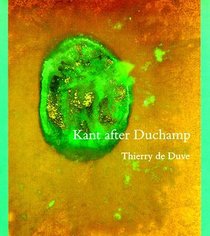Search -
Kant after Duchamp (October Books)
Kant after Duchamp - October Books
Author:
"You don't have to agree with all of Thierry de Duve's premises and arguments (needless to say I don't) in order to recognize that he has written a remarkable book. The essays gathered in Kant After Duchamp mount the most formidable case yet made for Duchamp's importance, and what makes de Duve's achievement all the more unexpected is tha... more »
Author:
"You don't have to agree with all of Thierry de Duve's premises and arguments (needless to say I don't) in order to recognize that he has written a remarkable book. The essays gathered in Kant After Duchamp mount the most formidable case yet made for Duchamp's importance, and what makes de Duve's achievement all the more unexpected is tha... more »
ISBN-13: 9780262041515
ISBN-10: 0262041510
Publication Date: 5/10/1996
Pages: 500
Rating: ?
ISBN-10: 0262041510
Publication Date: 5/10/1996
Pages: 500
Rating: ?
0 stars, based on 0 rating
Publisher: The MIT Press
Book Type: Hardcover
Other Versions: Paperback
Members Wishing: 1
Reviews: Amazon | Write a Review
Book Type: Hardcover
Other Versions: Paperback
Members Wishing: 1
Reviews: Amazon | Write a Review
Genres:
- Arts & Photography >> Individual Artists >> ( D-F ) >> Duchamp, Marcel
- Arts & Photography >> Individual Artists >> General
- Arts & Photography >> History & Criticism >> General
- Arts & Photography >> History & Criticism >> Criticism
- Nonfiction >> Philosophy >> Aesthetics




